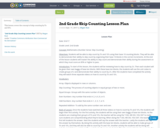
This lesson covers the concept of skip counting by 5's and 10's.
- Subject:
- Mathematics
- Material Type:
- Lesson
- Date Added:
- 09/04/2017

This lesson covers the concept of skip counting by 5's and 10's.
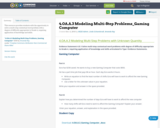
This resource provides students with the opportunity to solve a multi-step contextual word problem with a degree of difficulty appropriate to Grade 4, requiring application of knowledge and skills.
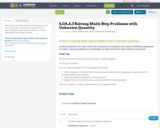
This resource provides students with the opportunity to solve a multi-step contextual word problem with a degree of difficulty appropriate to Grade 4, requiring application of knowledge and skills.
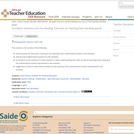
The solutions unit consists of the following: General points for discussion relating to the teaching of the mathematical content in the activities. Step-by-step mathematical solutions to the activities. Annotations to the solutions to assist teachers in their understanding the maths as well as teaching issues relating to the mathematical content represented in the activities. Suggestions of links to alternative activities for the teaching of the mathematical content represented in the activities.
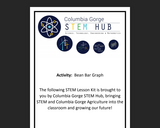
In this activity, kids will work on two fundamental early math skills – sorting/classifying, and graphing. There will also be some great fine motor skill practice! Includes place-based discussion questions, activity instructions, extension activities, songs, and student graph worksheets.
NGSS: K-LS1-1, 1-LS1-1, partially meets K-ESS3-1 (book and discussion)
Common Core: MP.4
Time: 45 minutes
Matierals: bag of dried beans ("16 bean soup"), paper bowls, glue, chart paper, the book "One Bean" or similar book about growing food plants, especially beans.

The COVID-19 Pandemic is a clear example of how science and society are connected. This unit explores how different communities are differentially impacted by the virus through the lens of historical inequities in society. In the context of decisions their families make, students explore the basics of how the virus affects people, and design investigations to explore how it spreads from person to person, and what we can do to prevent that spread.

The COVID-19 Pandemic is a clear example of how science and society are connected. This unit explores how different communities are differentially impacted by the virus through the lens of historical inequities in society. In the context of decisions their families make, students explore the basics of how the virus affects people, and design investigations to explore how it spreads from person to person, and what we can do to prevent that spread.

This task was developed by high school and postsecondary mathematics and design/pre-construction educators, and validated by content experts in the Common Core State Standards in mathematics and the National Career Clusters Knowledge & Skills Statements. It was developed with the purpose of demonstrating how the Common Core and CTE Knowledge & Skills Statements can be integrated into classroom learning - and to provide classroom teachers with a truly authentic task for either mathematics or CTE courses.

The City X Project is an international educational workshop for 8-12 year-old students that teaches creative problem solving using 3D printing technologies and the design process. This 6-10 hour workshop is designed for 3rd-6th grade classrooms but can be adapted to fit a variety of environments. Read a full overview of the experience here: http://www.cityxproject.com/workshop/
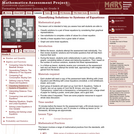
This lesson unit is intended to help teachers assess how well students are able to classify solutions to a pair of linear equations by considering their graphical representations. In particular, this unit aims to help teachers identify and assist students who have difficulties in: using substitution to complete a table of values for a linear equation; identifying a linear equation from a given table of values; and graphing and solving linear equations.
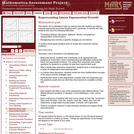
This lesson unit is intended to help teachers assess how well students are able to interpret exponential and linear functions and in particular to identify and help students who have the following difficulties: translating between descriptive, algebraic and tabular data, and graphical representation of the functions; recognizing how, and why, a quantity changes per unit intervale; and to achieve these goals students work on simple and compound interest problems.

Explore a NetLogo model of populations of rabbits, grass, and weeds. First, adjust the model to start with a different rabbit population size. Then adjust model variables, such as how fast the plants or weeds grow, to get more grass than weeds. Change the amount of energy the grass or weeds provide to the rabbits and the food preference. Use line graphs to monitor the effects of changes you make to the model, and determine which settings affect the proportion of grass to weeds when rabbits eat both.

Explore how populations change over time in a NetLogo model of sheep and grass. Experiment with the initial number of sheep, the sheep birthrate, the amount of energy sheep gain from the grass, and the rate at which the grass re-grows. Remove sheep that have a particular trait (better teeth) from the population, then watch what happens to the sheep teeth trait in the population as a whole. Consider conflicting selection pressures to make predictions about other instances of natural selection.
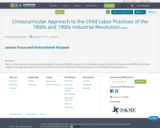
This a a cross curricular unit encompassing English, History, and Math Common Core Standards to teach the Child Labor practices of 1800s U.S. with the tragedy of Triangle Shirtwaist Factory Fire of 1911 which lead to child labor reform throughout the world and into the modern era.

Learn to connect position-time and velocity-time graphs. Explore velocity using an animated car icon connected to either a position-time or a velocity-time graph, or both. Then investigate other motion graphs.
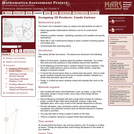
This lesson unit is intended to help teachers assess how well students are able to: Select appropriate mathematical methods to use for an unstructured problem; interpret a problem situation, identifying constraints and variables, and specify assumptions; work with 2- and 3-dimensional shapes to solve a problem involving capacity and surface area; and communicate their reasoning clearly.
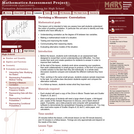
This lesson unit is intended to help teachers assess how well students understand the notion of correlation. In particular this unit aims to identify and help students who have difficulty in: understanding correlation as the degree of fit between two variables; making a mathematical model of a situation; testing and improving the model; communicating their reasoning clearly; and evaluating alternative models of the situation.
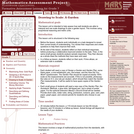
This lesson unit is intended to help assess how well students are able to interpret and use scale drawings to plan a garden layout. This involves using proportional reasoning and metric units.

In this capstone course, students will use new and previous knowledge about drug delivery and biopharmaceutics, to design an innovation. Throughout the course students will engage in learning opportunities related to real-world scenarios in drug delivery, gain a better understanding of the anatomy and physiology related to drug delivery, and participate in a self-directed project to solve a fictitious problem. This learning tool will guide students through the process of understanding real-world applications of drug delivery and how drug delivery is applied to treating infectious diseases. DDF’s innovation project is aligned with NGSS and Common Core standards in math and ELA core curriculum subject areas. The learning activities, final project, and mid-unit assessments are provided to the teacher and students in the form of eLearning readings, quizzes, interactive tools, student response sheets, and presentation outlines. Students using this module should find success in self-directed learning, though they may use additional resources in the community, the guidance of teachers, the advice of scientists or biomedical professionals at DDF, or the knowledge presented in scientific literature to help them achieve their goal; though this module should provide most of the tools they will need for guidance. For more information on in-person learning experiences, please contact our DDF eLearning Project Manager, Lindsay Malcolm: lmalcolm@tsrlinc.com

Use a series of interactive models and games to explore electrostatics. Learn about the effects positive and negative charges have on one another, and investigate these effects further through games. Learn about Coulomb's law and the concept that both the distance between the charges and the difference in the charges affect the strength of the force. Explore polarization at an atomic level, and learn how a material that does not hold any net charge can be attracted to a charged object. Students will be able to: